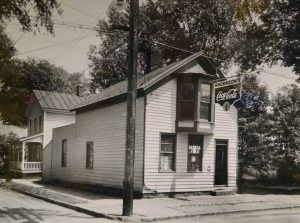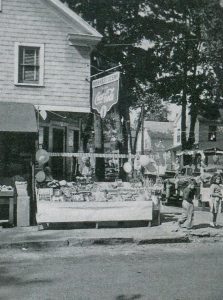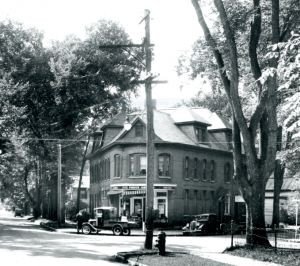The moment my friends and I were allowed to ride our bikes to the Stop-n-Go to go buy candy from the change we had saved was a moment of freedom. During the summer, we almost went daily to pick up gum, candy, and chocolate bars. Stop-n-Go, a small convenient store, was the equivalent to what used to be the local store that many towns across the country had on many neighborhood streets and corners. Unfortunately, many local stores have disappeared. Often all that remains are the memories and the building that stands as a reminder. It is hard to imagine that at one time there were over 50 corner stores scattered throughout Saratoga Springs.

Anderson’s Grocery, once located at 10 Warren Street. This was one of many local grocers that filled the residential areas of Saratoga Springs.
Carol Godette was born and raised in Saratoga Springs. One of her fondest memories of growing up in Saratoga Springs was going to her neighborhood grocery store. She used to go around the corner to Rowlands with her friend to buy penny candy. On occasion, Mr. Rowland would ask Carol and her friend to watch the store while he ran out to collect his bets. Not surprising, it was not necessarily uncommon in Saratoga Springs for an owner of a mom and pop establishment to also be a bookie. “I felt so grown-up and important watching over the store. I enjoyed seeing the regulars and learning the interworkings of a local grocery store,” reminisced Carol.

193 Elm Street, date unknown.
One store’s history that Carol is particularly fond of is that of Arpey’s at 193 Elm Street. The building remains, but the hustle and bustle that must have taken place at the store no longer does. Crestina Cappello arrived from Italy with only $2 in her pocket. Her mother passed away when she was only six years old. Her aunt and uncle who were living in the United States arranged a marriage for her at the age of 16. After arriving in New York City she married a stranger with the last name Arpaia. He worked on the railroad and by the time the family had settled in Saratoga Springs she had given birth 14 times, losing four of her children. Her husband did not provide as much as was necessary. She Americanized her name to Christine Arpey and started to bootleg in order to raise money to establish her own legitimate business. Between the brewing of beer, making wine, and making whiskey extract from orange peels in addition to selling vegetables that she grew door-to-door, she was able to open her store in 1934. It was a full-service Italian import store that sold homemade tomato sauce, ricotta cheese, and raviolis as well as fresh produce from her gardens and her famous sausage.

Several years ago, Carol walked by the now little used garage at the end of East Harrison Street that once housed her favorite neighborhood store. “There was such a sense of a community at the store and I’m sad that it is gone,” lamented Carol. The current owner allowed Carol the opportunity to go inside. “The shelves are still there, it is much like how I remembered,” she said. It was the sense of lost history that inspired Carol upon retiring after 30 years as an elementary school teacher in Greenfield and most recently at Lake Avenue School to research many of these mom and pop establishments and write a series of articles to share their history.
Crestina worked hard to create a successful business, but never forgot her struggles and would help those in need, often allowing customers up to two weeks to pay. As she grew older, her son Joe helped and took the store over upon her death. Carol said, “She exemplified the American Dream, an orphan who came to the United States who worked hard to be successful.”

Locations of all local grocers in Saratoga Springs’ history.
In 1911, when Saratoga Springs’ population was 13,000, there were 53 neighborhood grocery stores listed in the City Directories, and that did not include the 30 local butcher, fish, poultry, and vegetable markets that often sold other items as well. The combination of changes in refrigeration to allow families to have larger refrigerators, increased car ownership, construction of supermarkets with extended hours, and changes in government regulation of food led to slow the disappearance of local neighborhood establishments. While Saratoga Springs’ population had increased to 17,000 by 1978, only 13 neighborhood shops remained in operation.

Original photo of Five Points, 1935
One neighborhood store that still remains is Five Points Market and Deli, located at the intersection of Lincoln Avenue, Park Place, Jefferson Street, and Clark Street. In 1874, the building was home to the Saint James Hotel. While building’s appearance has changed over the years as well as the commercial tenants and residents who live above, Five Points has remained for nearly 100 years. Its location in a stable residential neighborhood and close proximity to Saratoga Race Course have certainly played a role in its longevity and today its deli sandwiches and friendly staff still make it a popular destination.
In recent times, Stewart’s Shop’s has found success as a convenient store chain that has filled the void that was left by the closing of many mom and pop stores. Prior to establishing Stewart’s Shops, Charles V. Dake and Percy W. Dake sold milk and butter from their dairy farm in Middle Grove to many local neighborhood stores in Saratoga Springs. In 1921, they found much success by making “Dake’s Delicious Ice Cream” which was also widely distributed to many local shops such as Ebert’s at 294 Caroline Street and Desidoro’s shop at 143 Grand Avenue.
Founded in 1977, the Saratoga Springs Preservation Foundation is a private, not-for-profit organization that promotes preservation and enhancement of the architectural, cultural and landscaped heritage of Saratoga Springs. To learn more or to join please visit www.saratogapreservation.org.
